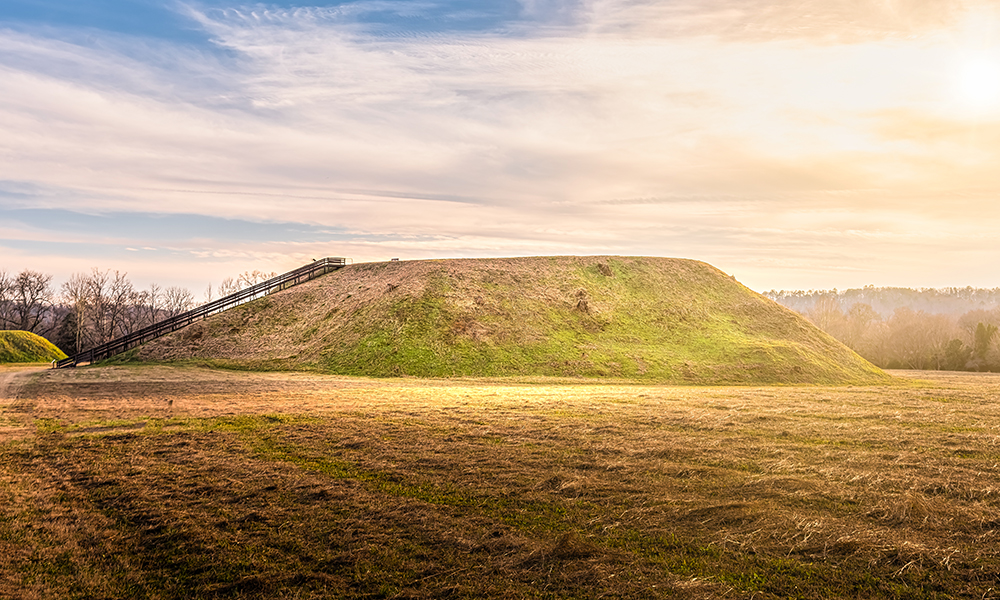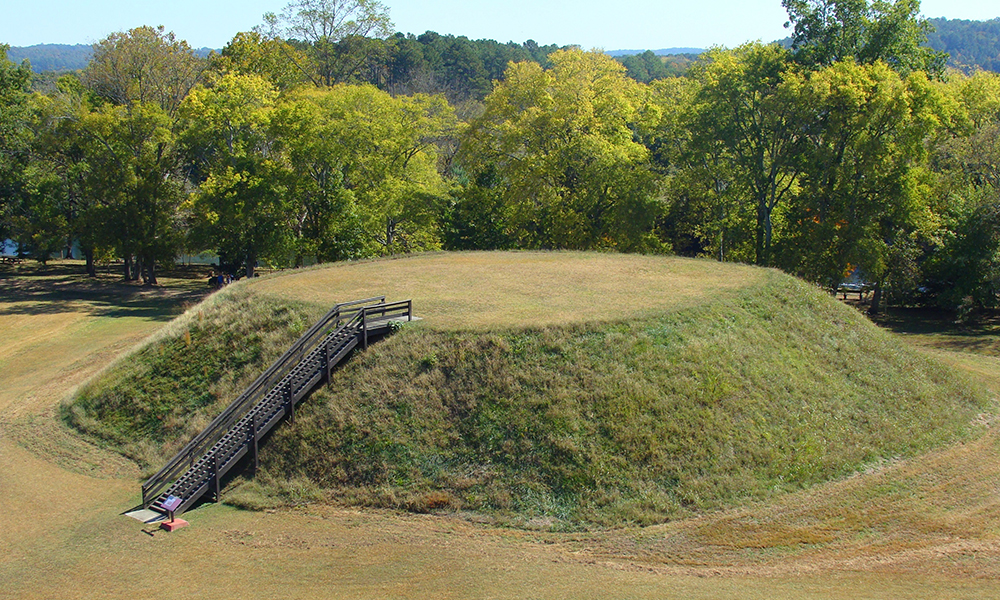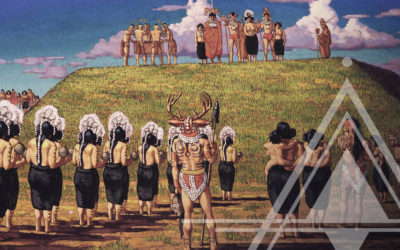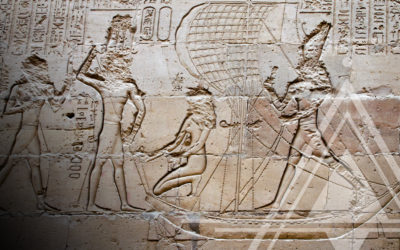Adam Oliver Stokes
The Mound Builders & the Egyptian Origin of America’s Pyramids
Sept 18
Adam Oliver Stokes
Tags
Introduction
Unbeknownst to many, North America is home to various ancient architectural wonders rivaling those found elsewhere in the world whether these be the pyramids of Egypt or the Great Wall of China. The gigantic mounds scattered throughout the mid/mid-Western United States, though often overlooked by laypersons and scholars alike, have nonetheless fascinated Americans since the founding of the nation. As historian Fawn Brodie notes, early 19th century newspapers-somewhat reflecting the racism of their day-argued that the mounds pointed to a civilization that “‘had made much greater advances in the arts of civilized life’ than any Indians” and that their construction in the distant past “clearly prove them to be the work of some other people.” James Vieira, in his work on ancient American giants, observes that this interest in the mounds and their builders extended even into American politics as seen in Abraham Lincoln’s reference to “that extinct species of giant, whose bones fill the mounds of America.”
Notwithstanding this interest, the identity of the mound builders has been consistently shrouded in mystery throughout the centuries. In the 19th century, writers on the subject suggested that they were giants. In the 20th century, scholars and researchers were somewhat more specific and, as the late Dr. Mark Lynott did in his excellent work, connected the mound builders with the Hopewell and Adena cultures of ancient America. Nevertheless, few serious students of the subject have attempted to determine the origin of these Hopewell and/or Adena giants. If, as even mainstream scholars suggest, these cultures were not indigenous to the continent and preceded (while at the same time interacting and being influenced by) Native American cultures then where did they come from? Is there a specific place of origin that can be located beyond the American continent?

The Mounds of Ancient America
Before examining the origin of the mound builders, it is necessary to first discuss in brief the mounds themselves and the work that has been done on them. When scholars mention the North American mounds they are referring to earthen constructions/earthworks ranging from merely 3 feet to a whopping 100 feet in height and covering at times thousands of feet in width and diameter. The mounds appear to have been used primarily-though not exclusively-for religious and ceremonial purposes including ritualistic burial and were usually erected in the center of the various urban communities that existed in pre-Columbian America. Their dates range from the mid-4th millennium BCE to 1500 CE.
The mounds are found throughout the United States especially within the Great Lakes region. States where mounds feature prominently include Michigan, Ohio, Illinois, West Virginia and Mississippi. While scholars estimate that at one time, particularly in the pre-Columbian era, hundreds of thousands of mounds existed throughout the North American continent as of 2019 only a few hundred remain largely due to both deliberate and unintentional destruction. Some of the more prominent mounds still in existence include Monks Mound in Illinois, the Grave Creek Mound in West Virginia and the Great Serpent Mound in Ohio which itself spans nearly 1350-feet in length.
Academic research and study of the mounds dates back as far as the mid 19th century beginning with Ephraim Squier’s groundbreaking work Ancient Monuments of the Mississippi Valley published in 1848. While speculated by scholars and writers before him, Squier was the first researcher to openly argue for a distinct civilization in America that preceded that of the Indian tribes and was responsible for the building of the mounds. At the same time, he did not explicitly identify this civilization or where it originated from.

Of particular importance for scholars dealing with ancient America were the various excavations done at the Hopewell/Adena mounds which revealed numerous skeletal remains of gigantic persons ranging from 7 to 9 feet in height. These findings have been written about extensively by researchers such as Richard Dewhurst and Fritz Zimmerman both of whom have surmised the existence of a pre-Columbian race of giants. Given the evidence for ancient giant civilizations elsewhere in the world this raises the question of whether these North American giants were indigenous to the continent or came from elsewhere. If the latter is the case, were they connected to a specific Old World culture or empire?
Parallels with the Egyptian Pyramids: Implications for Identification
Of the many things that traditional North American archaeology has overlooked about the ancient mounds, the parallels between the design of the mounds as well as their function and purpose in relation to the great monuments of Egypt has not been one of them. Many of the mounds, such as Monks Mound in Illinois, mirror the triangular shape of the ancient Egyptian pyramids. Furthermore, as with the Egyptian pyramids, the mounds appear to have served some type of religious purpose related to the afterlife in some way. Just as the Egyptian pyramids housed the bodies of the pharaohs as a way station between this life and the next so the American mounds entombed the bodies of the upper-class members of Hopewell/Adena culture who, like the pharaohs, had their prized possessions buried with them perhaps as a way of retaining these objects in the world beyond death.
In a recent discussion for Lost Origins podcast, researcher and scholar Frank Joseph correctly noted these types of parallels between the American mounds and the Egyptian pyramids. In particular, he highlighted that the dimensions of the mounds (length, width and height) corresponded exactly to those of the Giza pyramids. At the same time, Joseph dismissed the idea of direct cultural influence of the Old World on the New (in regards to the mounds specifically). Rather, he argued that the parallels originated from an Atlantean or pre-Atlantean source and that the human race had retained this knowledge and passed it on from generation to generation worldwide. In other words, if I understand Joseph’s argument correctly, one cannot identify the mound builders as an example of a Near Eastern culture (in this case, the Egyptians) that migrated across the Atlantic to the Americas.
While Joseph’s suggestion of an Atlantean influence is certainly plausible, I want to suggest here an alternative view that, in my opinion, takes into consideration the various features of the mound builder culture that do correspond and connect with the ancient Near East. While I will briefly touch on some of these features here I discuss them in significantly more detail in my upcoming book From Egypt to Ohio: A Semitic Origin for the Giants of Ancient America.
As various researchers on the Hopewell/Adena giants have noted, excavations of the mounds have uncovered significant examples of Semitic culture including inscriptions and artifacts. These have been documented extensively by writers such as Richard Dewhurst and Fritz Zimmerman. They include several items with Hebrew inscriptions on them such as the Newark Holy Stones, the Hebrew Bat Creek Stone, the Michigan relics and, most important for our consideration here, a tablet found in Muskinghum County Ohio written in Egyptian hieroglyphics but containing a quote from the Hebrew Bible as reported in the December 2017 issue of Ancient American magazine. In addition, certain artifacts related to the religious practices of the Hopewell, apart from written inscriptions, reflect Semitic influence.
The term “semitic”, while commonly and correctly associated with the Jewish race (descended from the biblical Hebrews), can be applied to various cultures and groups, extant and extinct, in the Near Eastern region. Hence, Phoenician, Moabite and ancient Egyptian culture can be labelled “semitic” as well. These groups all share/shared similarities in their cultural customs and even in their language. While most people automatically associate the Egyptian language with pictoral hieroglyphics it is less known that the consonantal and phonetic equivalent for these pictoral symbols bears close resemblance to the grammar found in other Semitic languages such as biblical Hebrew.
When looking at the Hopewell/Adena, one need not suppose that the presence of Hebrew inscriptions disqualifies an association or relation to ancient Egypt (over and above identification with the ancient Israelites). Ancient Egyptian culture was as influenced by biblical Israel just as much as biblical Israel interacted and was influenced by ancient Egypt. Many of the heroes and narratives found in the Tanakh or Old Testament are also found in ancient Egyptian texts.
Furthermore, ancient Jews and Egyptians corresponded regularly in a variety of Semitic languages with the former group sometimes writing in hieroglyphics and demotic and the latter writing in Hebrew. The finding of Semitic inscriptions, particularly hieroglyphics, in addition to the parallels between the American mounds and the Egyptian pyramids is strong evidence that we can make an explicit identification of the mound builder giants as Egyptian or descended from ancient Egypt rather than assuming the traditional ambiguity regarding their point of origin.
Conclusion
In summary, this article has attempted to provide a specific geographical and cultural place of origin for the ancient (giant) builders of the American mounds. This issue has largely been overlooked by mainstream American archaeologists and anthropologists who have argued for ambiguity regarding the mound builders identification and have preferred to accept the view that they were merely “earlier inhabitants” of the continent who later integrated with the Hopewell/Adena peoples. Based on architectural and cultural parallels with Semitic groups in the Near East, I have explicitly identified the mound builders as Egyptian in origin.
If my argument in this article is correct, it would provide an excellent example of the cultural diffusionism that several scholars, from Frank Joseph to Fritz Zimmerman, have argued for in recent decades. In any case, the bulk of the archaeological evidence makes it clear that a diffusionist model for ancient American civilization can no longer be dismissed and that the traditional migrationist view is deeply flawed. It is my hope that this study and others will encourage archaeologists and anthropologists to re-examine the importance of the American mounds for understanding pre-Columbian American history and to finally give the mounds the attention they rightly deserve.
References
- F. Brodie, No Man Knows My History (New York: Vintage, 1995), 34-35.
- J. Vierra, “When Giants Ruled America,” in The Lost History of Ancient America, ed. F. Joseph (Pompton Plains, NJ.: New Page, 2017), 177-82.
- See, M. Lynott, Hopewell Ceremonial Landscapes of Ohio: More Than Mounds and Geometric Earthworks (Havertown, PA: Oxbow, 2014) and B. Lepper, Ohio Archaeology: an Illustrated Chronicle of Ohio’s Ancient American Indian Culture (Wilmington, OH.: Orange Frazer, 2005).
- Some notable examples of Joseph’s groundbreaking work on ancient America in addition to the material in the above footnote include The Lost Colonies of Ancient America: A Comprehensive Guide to the Pre-Columbian Visitors who really discovered America (Pompton Plains, NJ.: New Page, 2014); The Lost Worlds of Ancient America: Compelling Evidence of Ancient Immigrants, Lost Technologies and Places of Power (Pompton Plains, NJ.: New Page, 2012) and The Lost Treasure of King Juba: The Evidence of Africans in America before Columbus (Rochester, VT.: Bear & Company, 2003).
- See, E. Squier and E. Davis, Ancient Monuments of the Mississippi (150 anniversary ed.; Washington, D.C.: Smithsonian Books, 1998).
- See, G.R. Milner, The Moundbuilders: Ancient Peoples of Eastern North America (London: Thames & Hudson, 2004).
- It should be noted that other scholars have argued that the Egyptian pyramids served a primary secular or non-religious purpose. Steve Myers, who has done extensive research on the pyramids, argues that the Giza pyramid in particular was an ancient mechanical device. See, S. Myers, Lost Technologies of the Great Pyramid (2010).
- See, F. Joseph, “Power Places and the Master Builders of Antiquity.” Audio blog post. Lost Origins. 1 July 2019. Accessed 2 September 2019. Joseph also presents a similar argument in his recent book, Advanced Civilizations of Prehistoric America: The Lost Kingdoms of the Adena, Hopewell, Mississippians, and Anasazi (Rochester, VT.: Bear & Company, 2010).
- I wanted to clarify that Joseph argues for this specifically and exclusively in regards to the American mounds since his work clearly falls into the diffusionist category.
- See, R. Dewhurst, The Ancient Giants who Ruled America: The Missing Skeletons and the Great Smithsonian Cover-Up (Rochester, VT: Bear & Company, 2014); F. Zimmerman, The Encyclopedia of Ancient Giants in North America (2015).
- Included amongst this are female/fertility figurines similar to the pillar figurines of Asherah excavated in Iron II Judah. See my upcoming article “Judean Pillar Figurines in the mid-West,” in Ancient American magazine (Sept. 2019).
- For a lay discussion of the parallels between ancient Hebrew and Egyptian including comparative charts and diagrams, see, “Comparison Between the Paleo-Hebrew alphabets and Hieractic Egyptian and the Phoenician Alphabet” Minoan Linear A, Linear B, Knossos & Mycenae 28 April 2015. Accessed 14 September 2019.
- In addition to a papyrus found in 1831 which contains a narrative purportedly written by the biblical patriarch Abraham himself in the first person, several other Egyptian texts contain references to Old Testament figures. For a discussion of this phenomenon, see, J. Gee, “Research and Perspectives: Abraham in Ancient Egyptian Texts,” Ensign 22(7) (1992). While Gee is writing from a Latter-Day-Saint perspective, in which the connection between Egypt and the Bible figures prominently, he is an accomplished and well renown Egyptologist and scholar. Also, see, A. Georgiou, “Ancient Egypt: 1500-year-old Papyrus Contains Stories of Biblical Human Sacrifice,” Newsweek. 19 April 2018. Newsweek.com/1500-year-old-ancient-egyptian-papyrus-contains-stories-biblical-human-891667. Accessed 2 September 2019. Georgiou notes that “the writing makes several references to God as ‘the one who presides over the Mountain of the Murderer’-a nod towards the story of Abraham in the Book of Genesis, in which Abraham is asked to sacrifice his son Isaac.” Perhaps the most notable example of ancient Jewish/Egyptian interaction is seen with the community of Elephantine that existed for a thousand years beginning in the 5th century BCE and whose documents were written in Hebrew, Egyptian and Greek.

About the Guest
You May Also Like
Join Our Mailing List
Spam sucks. We take your privacy seriously and we will never spam your inbox. You can opt out at any time.



